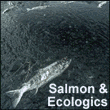forum
library
tutorial
contact

Preliminary Report says
Potlatch Discharge Harmful to Fish
by Barry EspensonColumbia Basin Bulletin - April 25, 2003
|
the film forum library tutorial contact |

|
Preliminary Report saysby Barry Espenson |
The federal agency charged with protecting beleaguered Snake River salmon and steelhead populations has determined, in a preliminary document, that wastewater from the Lewiston Potlatch Corp. pulp mill can be lethal to salmon and is "likely to jeopardize the continued existence of Snake River steelhead, Snake River spring/summer and fall chinook salmon and Snake River sockeye salmon."
The company, however, says the preliminary document issued March 17 by NOAA Fisheries (formerly the National Marine Fisheries Service) is wrong. Potlatch is amidst an effort to compile the necessary scientific information it says will prove that the plant's discharge neither kills nor harms migrating fish.
The NOAA "discussion draft" evaluates the effects of the discharges on federally listed salmon and steelhead as part of a U.S. Environmental Protection Agency process to issue a new wastewater discharge permit for Potlatch. The steelhead and salmon are all listed under the Endangered Species Act and pass the pulp mill on their way to and from the Pacific Ocean and spawning grounds.
In a draft on the proposed permit was released to EPA, Potlatch and Idaho Department of Environmental Quality, NOAA Fisheries concluded that the Potlatch operations proposed in the permit are "likely to jeopardize the continued existence" of the listed species even if Potlatch makes the improvements called for in the new permit.
The federal agency draft also "determined the proposed permit limits will allow toxic chemical and physical parameters of waste discharge to reach concentrations that are likely to result in destruction or adverse modification of critical habitat as a result of physical and chemical contamination of the water column and sediments, and bioaccumulation of toxic chemicals in prey species eaten by listed salmon."
Among the findings by NOAA Fisheries are:
EPA is expected to propose modifications to its proposed new permit, which may address the issues raised by NOAA Fisheries. A new permit proposal should be available for a 30-day public comment period starting in late April. Potlatch intends to try convince the NOAA that the agency's initial opinion is wrong.
"It's definitely a serious heads up," said John Palmer, EPA Region 10 Office of Water senior policy adviser for Clean Water Act and ESA issues. "We're going to be working closely with the services to try resolve some of those issues."
EPA staff are working with NOAA and the U.S. Fish and Wildlife Service, poring over the details of the draft document and trying to understand what assumptions were used to make its conclusions. Palmer said that if biological issues cannot be resolved, the conditions of the permit would likely have to be changed.
"It's a draft biological opinion. It's still subject to revision, subject to new information," Mark Benson, Potlatch's director of public affairs, said this week. Work is ongoing to short up and better validate the scientific conclusions of the "biological assessment" prepared by Potlatch for the permit process. That assessment was used as justification for the permit.
"We believe that there is no scientific data that shows Potlatch discharge has resulted in any fish kill" or harm to listed species, Benson said.
Consultation between NOAA Fisheries and the EPA regarding the impact of pollution discharges was forced by a 1999 lawsuit filed by Idaho Rivers United, Idaho Conservation League and The Lands Council. As a result of that case, EPA began the formal consultation process in 2000. The organizations were represented in the case by Advocates for the West.
Of particular concern to salmon survival is EPA's requirement that the mill's discharge meet Idaho water quality standards for temperature during the summer months.
According to the draft opinion:
"We don't agree with the notion that there is any thermal plume that serves as a migration barrier," Benson said.
Palmer said Thursday that new, more sophisticated temperature modeling techniques are now available to better evaluate thermal effects of the discharge.
NOAA Fisheries also determined that the assumptions used by EPA to determine how much water is available for diluting the many toxic chemicals associated with chlorine-based pulp and paper making have been exaggerated, according to a press release issued by the conservation groups this week.
"NOAA Fisheries has done a very credible job of examining the science and real-life, in-the-river facts," said Bill Eddie of Advocates for the West. "EPA must now translate the agency's work into a permit that will be protective of Idaho's salmon and steelhead."
"This document clearly shows that salmon and steelhead are being harmed by the Potlatch operation," said Bill Sedivy, executive director of Idaho Rivers United. "Now, we hope that the company will do what's right for salmon, and the health and welfare of the Lewiston-area, by addressing these pollution problems at the mill."
"It is possible for salmon and the mill to both thrive," said Justin Hayes of the Idaho Conservation League. "Potlatch must change to a chlorine-free bleaching process and closed loop system to eliminate the pollution that is killing our salmon and steelhead."
"Potlatch must take immediate steps to decrease the danger of their mill to Idaho's wild salmon and steelhead," said Mike Petersen of The Lands Council. "This year's out-migration of young fish must be given a better chance to survive than Potlatch has given them in the past."
The Potlatch mill continues to operate under the terms of their 1992 permit, which allows more than 40 million gallons of up to 92 degree F wastewater to be discharged daily.
The full text of the NOAA Fisheries draft Biological Opinion can be viewed at www.idahorivers.org or at
learn more on topics covered in the film
Barry Espenson
Preliminary Report says Potlatch Discharge Harmful to Fish
Columbia Basin Bulletin, April 25, 2003
see the video
read the script
learn the songs
discussion forum
